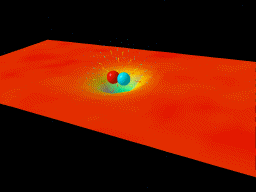Hadron Structure

- How are quarks and gluons confined in strongly interacting particles (hadrons)?
- What is the structure of the proton and neutron, and how do hadrons get their mass and spin?
Electron scattering in the 1950s provided the experimental evidence for the parton theory of the nucleon and opened the door to decades of its exploration. The mechanism by which quarks and gluons are confined within hadrons, the generation of the hadronic mass from the minuscule bare masses of quarks, the composition of a hadron’s spin are all emergent properties of the unique complexity associated with the QCD Lagrangian and remain amongst the most important questions in fundamental physics. The internal dynamics of the hadron giving rise to its external properties are entirely non-perturbative phenomena which cannot be addressed within the theoretical framework of high-energy QCD and their exploration is crucial for a full understanding of the strong interaction and the composition of matter at the most fundamental level. The Glasgow group’s main focus on understanding hadron structure is through precision scattering experiments with electromagnetic beams on fixed nucleon targets, conducted in halls A, B and C of Jefferson Laboratory. The facility has just completed an upgrade of its electron beam accelerator to operate at a maximum energy of 12 GeV, towards which we contributed in the design and construction of several detectors (the Central Neutron Detector for CLAS12 in Hall B, the BigBite and Super BigBite Spectrometers in Hall A and the Neutral Particle Spectrometer in Hall C). Our group is leading a number of experiments, as part of the CLAS and the Halls A and C collaborations, aimed at measuring cross-sections and polarisation asymmetries in inclusive and exclusive reactions, which give access to different aspects of the quark spatial and momentum distributions: Deeply virtual Compton scattering (DVCS) allows an extraction of Generalised Parton Distributions (GPDs), which offer a three-dimensional image of the nucleon by relating the transverse position of partons to their longitudinal momentum. Measurements of GPDs on proton and neutron targets will provide crucial information on the contribution of the total angular momentum of quarks to the nucleon spin, the composition of which is one of the main outstanding puzzles in hadron physics. Elastic and Wide-Angle Compton Scattering, where there is a large momentum transfer to the nucleon, lead to the extraction of nucleon form factors that represent 1D spatial distributions of partons. This provides information on the distribution of charge within the nucleons and has recently highlighted the important role played by quark orbital angular momentum and two-photon exchange in the scattering process. Deep Inelastic Scattering (DIS) allows extraction of the Parton Distribution Functions (PDFs) that describe the 1D longitudinal momentum carried by the partons. Semi-Inclusive DIS (SIDIS) is associated with the Transverse Momentum Distributions (TMDs), which make it possible to study the 3D confined motion of the partons and describe the correlation between quark transverse momentum and nucleon spin.

